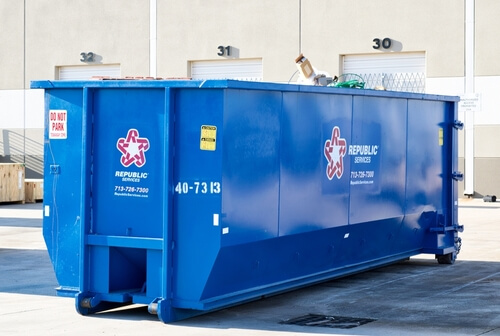Can You Use a Roll-Off with Hazardous Materials?
When it comes to waste management and transportation, roll-off containers, commonly known as dumpsters, have become indispensable tools. These versatile containers are capable of handling various materials, and yes — that does include hazardous substances.
However, the safe handling and transportation of hazardous materials requires strict adherence to regulations and guidelines to protect both human health and the environment. Let’s look at the intricacies of using roll-off containers with hazardous materials and highlight some essential safety and compliance considerations.
Determine Compatibility
Before transporting hazardous materials using a roll-off container, determine the compatibility between the container and the specific substance.
Different hazardous materials may demand specialized containers designed to withstand corrosion, pressure or potential leakage. Confirming compatibility with your environmental services team providing the dumpster is the first step towards safeguarding against accidents or spills that could have dire consequences.
Proper Labeling and Identification
Precise and accurate waste container labeling informs and protects those handling the hazardous materials. Appropriate labels and placards on the roll-off container enable personnel to identify and handle it with the necessary precautions. This ensures their safety and helps prevent cross-contamination and potential transport hazards.
Regulatory Compliance
Local, regional, and national authorities have established stringent guidelines for the handling, transportation and disposal of waste and hazardous materials. Familiarize yourself with these regulations and obtain any necessary permits, licenses or certifications, and ensure strict adherence to them. Compliance protects not just your organization but the communities and environment you serve.
Employee Training
Employees involved in transportation and handling of these substances should receive comprehensive training in safety procedures, emergency response protocols and the correct usage of personal protective equipment (PPE). Investing in employee training minimizes accidents and ensures they’re well-prepared for any unforeseen circumstances.
Containment and Leak Prevention
Preventing spills, leaks and releases during transport is essential for mitigating environmental hazards. Employing secondary containment systems like spill pallets or absorbent materials serves as an additional layer of protection. These measures are safeguards to keep hazardous materials from escaping while minimizing environmental and human health impact.
Proper Disposal Considerations
To prevent pollution and protect the ecosystem, it’s crucial to adhere to all regulations and guidelines during disposal. Hazardous waste should be treated, stored or disposed of at authorized facilities to ensure it won’t pose a risk to human health or the environment.
Following correct disposal procedures is a responsibility TAS Environmental Services takes seriously.
Ensuring Hazmat Management Safety with TAS Environmental Services
At TAS Environmental Services, we are committed to providing world-class hazardous waste management services. Our team of professionals is well-versed in the complexities of handling hazardous materials and ensuring compliance with regulations. With our expertise and commitment to safety, we offer comprehensive solutions for the safe transportation, disposal, and management of hazardous waste.
By partnering with a trusted and experienced company like ours, you can confidently manage hazardous waste and contribute to a safer and healthier future for all. Contact us today to learn more about our services and how we can help you navigate the intricacies of hazardous waste management.

